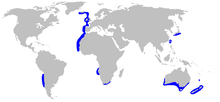Birdbeak dogfish
| Birdbeak dogfish | |
|---|---|
| Drawing by Bideault | |

| |
| Scientific classification | |
| Domain: | Eukaryota |
| Kingdom: | Animalia |
| Phylum: | Chordata |
| Class: | Chondrichthyes |
| Subclass: | Elasmobranchii |
| Subdivision: | Selachimorpha |
| Order: | Squaliformes |
| Family: | Centrophoridae |
| Genus: | Deania |
| Species: | D. calcea
|
| Binomial name | |
| Deania calcea (R. T. Lowe, 1839)
| |

| |
| Range of birdbeak dogfish (in blue) | |
The birdbeak dogfish (Deania calcea) is a
The birdbeak dogfish has a very long, narrow snout, no
In June 2018 the New Zealand Department of Conservation classified the birdbeak dogfish as "Not Threatened" under the New Zealand Threat Classification System.[3]
A study published in the Journal of the Marine Biological Association of the United Kingdom evaluated the reproductive strategy of the female deep-water shark birdbeak dogfish. This research article discovers that there is a close relationship that exists between Hg level of pregnant females and the Hg level of their embryos, which indicates that there is a transfer of mercury from maternal sources. Therefore, there is a matrophoric strategy for the birdbeak dogfish that are ovoviviparous.[4]
With the rise of fisheries, the birdbeak dogfish is being consumed at higher rates. It has been found to be a good source of minerals, such as potassium and sodium. However, there have been health risks associated with frequent consumption of female dogfish.[5]
References
- . Retrieved 19 November 2021.
- ^ a b Carpenter, Kent E.; Luna, Susan M. (2019). "Deania calcea (Lowe, 1839) Birdbeak dogfish". Fishbase. Retrieved 19 January 2019.
- OCLC 1042901090.
- ^ Paiva, R., Neves, A., Sequeira, V., Nunes, M., Gordo, L., & Bandarra, N. (2012). "Reproductive strategy of the female deep-water shark birdbeak dogfish, Deania calcea: Lecithotrophy or matrotrophy?" Journal of the Marine Biological Association of the United Kingdom, 92(2), 387-394. doi:10.1017/S0025315411001743
- ISSN 0007-070X.

